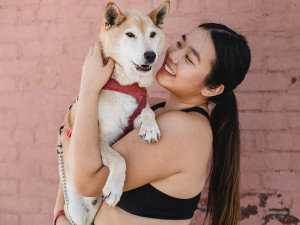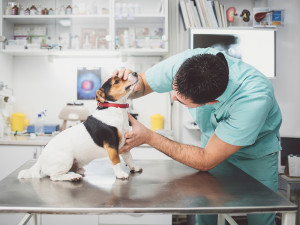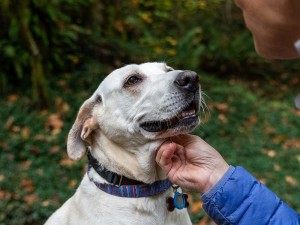Everything to Know About Canine Mast Cell Tumors to Keep From Freaking Out
The sooner you catch this common cancer, the better your chances are for giving your dog many more happy, healthy years.

Share Article
An old dog is an old friend, and we all want our friends to stay as healthy and happy as possible. That means staying aware of new challenges and issues that your dog might be facing as they enter their golden years. The scary truth is most dogs will develop a lump or bump as they age, or even a whole series of them. Don’t ignore them or write them off as just another old-dog thing, no matter how tempting it is to maintain the status quo. They absolutely can be just another old-dog thing and completely benign, but they could also be a mast cell tumor.
Mast cell tumors in dogs are one of the five cancers most frequently diagnosed in dogs and the sooner you catch them the better your chances are for giving your dog many more healthy, happy years by your side. With a little vigilance and know-how, you can stay on top of their condition. Here is everything you need to know about mast cell tumors in dogs.
What are mast cell tumors in dogs?
Under normal circumstances, mast cells are part of the immune system, responding to inflammation and allergic reactions. Among other things, mast cells contain granules of histamine, which are released during allergic or hypersensitivity reactions, like hay fever. They’re found in connective tissues, particularly those close to the surface. When mast cells start accumulating at a tissue site, a tumor can start.
Mast cell tumors account for about 20 percent of all skin tumors in dogs. They can be locally invasive, which sometimes makes them difficult to remove completely. The five most common types of dog cancer are mast cell tumors, melanoma, lymphoma, osteosarcoma, and hemangiosarcoma.

Signs and symptoms to keep an eye for.
If your dog has a lump that can be seen or felt, or both, should definitely be getting it checked. When a mast cell tumor involves other organs — generally, the spleen, lymph nodes or liver — your dog might have issues with vomiting, diarrhea, or a loss of appetite.
Are certain breeds predisposed to mast cell tumors?
Any dog breed or mix of any gender may develop mast cell tumors, but flat-faced breeds like Boston Terriers, Boxers, Pugs, Bulldogs, and Retriever breeds seem to be predisposed.
How are mast cell tumors in dogs diagnosed?
Part of diagnosing a mast cell tumor is making sure it’s not a lipoma, which is a benign fatty tumor that grows just beneath the surface of the skin. To check which it is, a veterinarian will use a thin hypodermic needle to get a sample from the lump. This technique is called fine needle aspiration and it’s very quick, and apparently well-tolerated by the patient. It’s also relatively inexpensive, although it’s not necessarily definitive. The sample is examined under a microscope and if it doesn’t provide enough cells or is otherwise inconclusive, the veterinarian may recommend that the lump be biopsied.
If it is a mast cell tumor, there are a few ways to grade it: the three-tier Patnaik and the newer two-tier Kiupel. Dr. Janet Patterson-Kane, Morris Animal Foundation’s chief scientific officer, considers the Kiupel system to be superior.
“The two-tiered grading system is a significant improvement in terms of predicting how mast cell tumors may behave, and better agreement between pathologists,” she says.
This grading will help veterinarians make decisions on how to treat the tumors. An X-ray or ultrasound or bone marrow sample might be used to figure out if the mast cell disease is localized in the tumor or systemic, which will give the vet more info for how to treat the problem.
Grades I and II tumors are usually surgically removed; when caught early and removed with a wide margin of healthy tissue, the prognosis is good. That being said, grade II tumors can present a dilemma; they may behave like grade I tumors or the more malignant grade III tumors. The latter are always surgically removed.
How are mast cell tumors in dogs it treated?
Mast cell metabolism has to be inhibited so it doesn’t keep growing or spreading. Vets generally prescribe corticosteroids, like prednisone. People with allergies might be familiar with using steroids and it works in a similar way. Prednisone given orally can be help shrink mast cell tumors. They might also inject a related steroid, such as triamcinolone, directly into the mast cell tumor at several sites to decrease the size of the tumor prior to surgical removal.
If the skin-based tumor is non-metastatic, meaning it hasn’t spread elsewhere, there’s a more recent therapy using tigilanol tiglate, a drug derived from the Australian blushwood plant. It stimulates the rapid destruction of mast cells within seven days of being injected into a tumor. This may avoid the need for surgery but does create a wound that needs to be managed during the healing process.
Sometimes surgery needs to be followed by another therapy. Radiation is more commonly used than chemotherapy. Chemo tends to be reserved for grade III tumors, although their response to it is unpredictable. Some dogs will require a second, more aggressive surgery. A dog who’s had one mast cell tumor is likely to develop another; these tend to be new tumors rather than evidence that the original tumor metastasized.
Mast cell tumors can also affect humans, and some drugs that have been developed for use in people could potentially work for canine patients, too. Toceranib phosphate (Palladia), the first tyrosine kinase inhibitor approved by the Food and Drug Administration for treatment of canine mast cell tumors, and masitinib (Masivet) both seem to help manage tumors and slowing their progression, without as much harm to the dog.
Susan Tasaki
Freelance writer Susan Tasaki lives in the San Francisco Bay Area with her Husky, who wishes they both got out more.
Related articles
![A vet examining the neck of a small dog on the examination table]()
Lymphoma Cancer in Dogs: What You Need to Know
Find out what causes lymphoma in dogs and how you can help your pup.
![A woman in a bright yellow-orange sweater holding a striped kitten in one hand and a credit card in the other while using her laptop in front of her]()
How to Get Help With Vet Bills for Dogs Who Need Surgery
Worried about the cost of making your pet feel better? Help is on the way.
![Closeup of white lab mix dog being pet under the chin by pet parent]()
Can Dogs Get Breast Cancer?
Sadly, yes — one in four dogs will develop mammary tumors — but there's an easy way to prevent them.
![]()
Cancer is More Common in Purebred Dogs, Study Says
Nationwide’s veterinary analytics team looked at the cancer claims of 1.61 million dogs and found that purebred dogs are nearly twice as likely to get cancer as mixed breeds.





